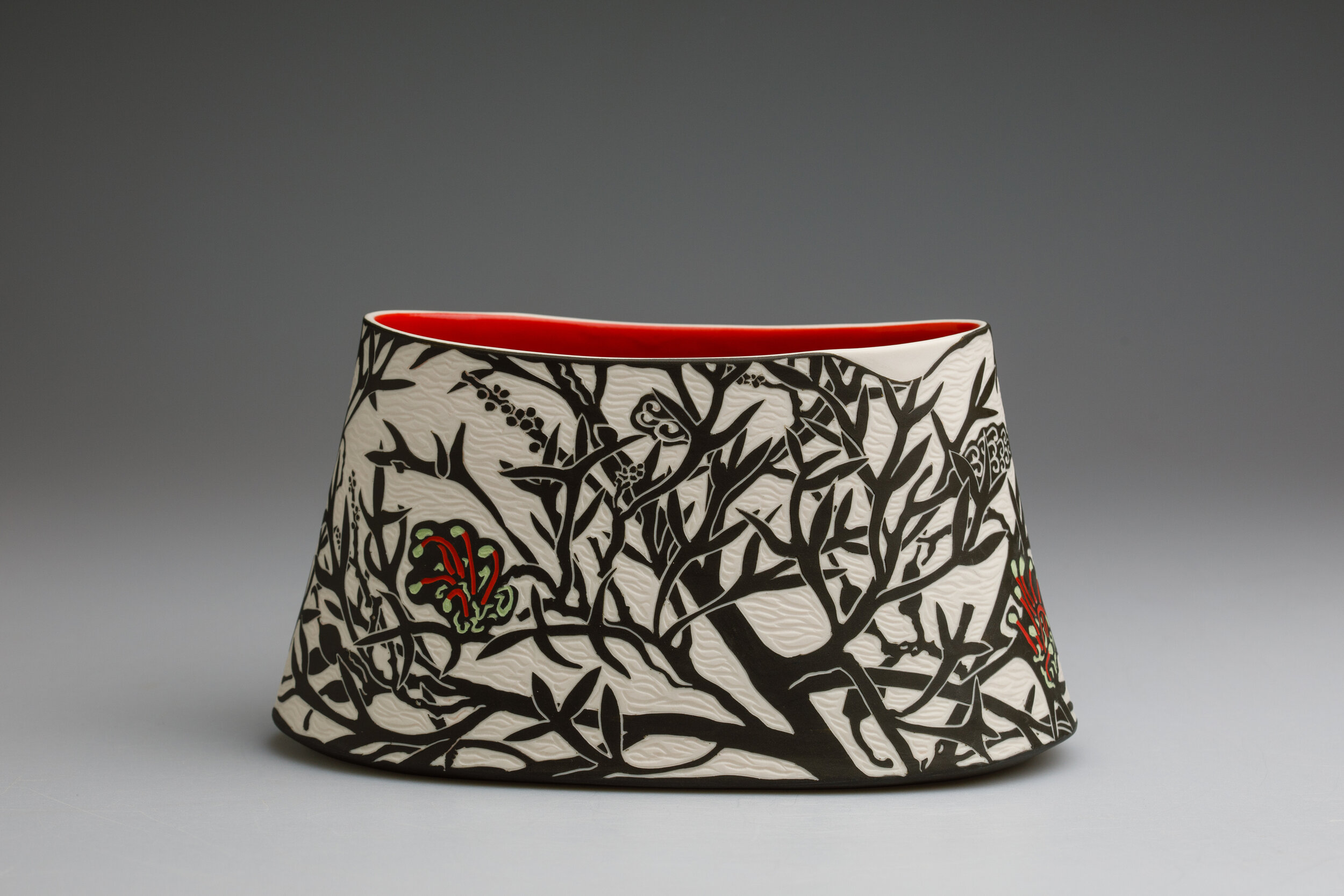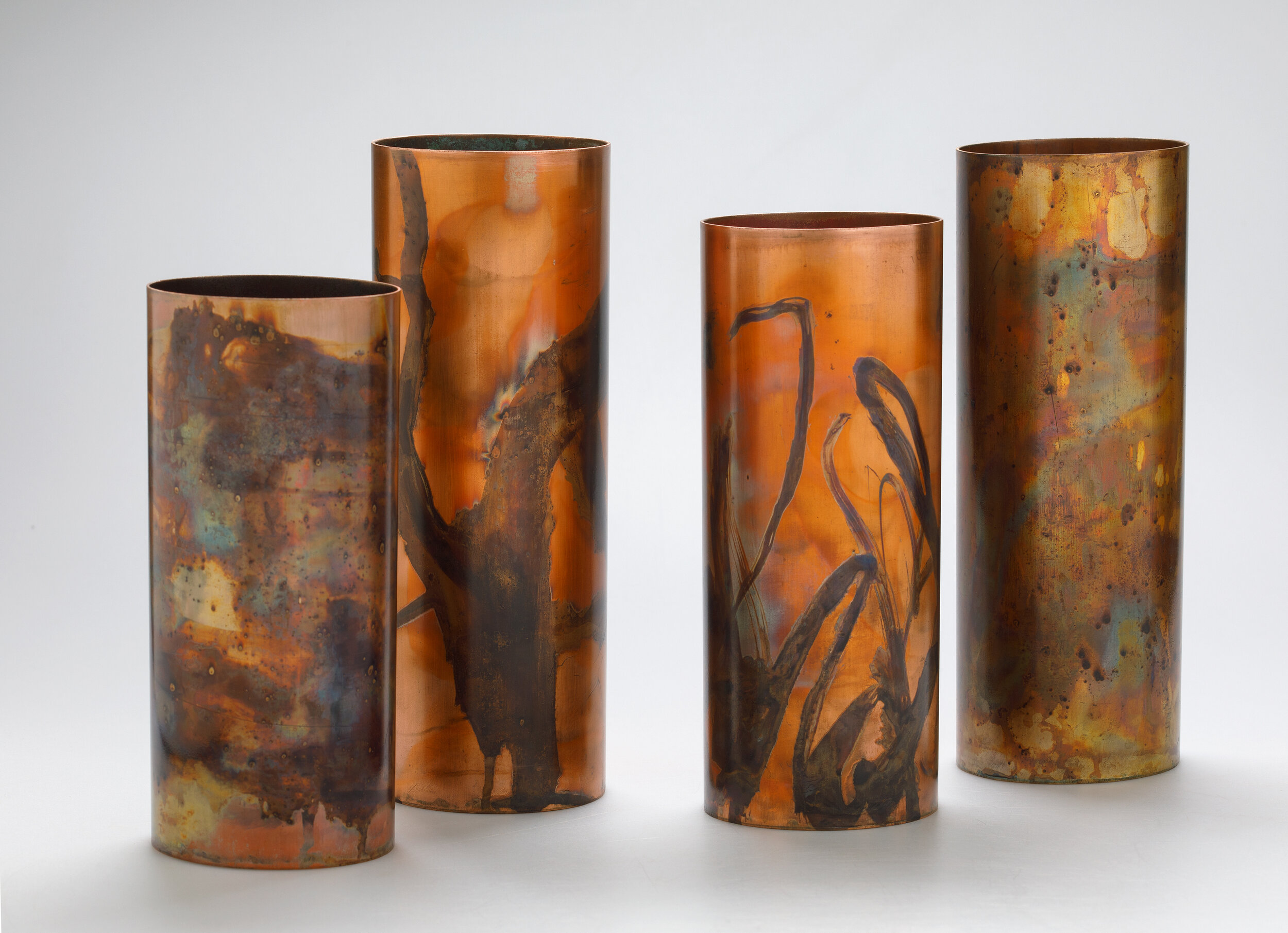Exhibition Insight... Autumnal Colours
Cathy Franzi, Coastal Umbrella Bush; Kangaroo Island Summer; Orange Bell Climber, 2020. Photographer: Andrew Sikorski-Art Atelier
"The heart of Autumn must have broken here, and poured its treasure upon the leaves.” Charlotte Fiske Bates (1838 – 1916), American writer and poet ‘Woodbines in October’, 1879
The vibrant beauty and sumptuous colours of Autumn have long been a source of inspiration to the creative sensibilities of poets and artists, who have endeavoured to capture both the physical and atmospheric elements of the season in their work. The exquisite palette of rich, warm tones that reflect Autumn are vast and varied in their hues: bronze, amber, chestnut, saffron, russet, maroon, copper, rust, tawny, ochre, crimson, gold, burgundy, orange, claret, gamboge, scarlet, auburn. The colours are synonymous with the season and spark visions of falling leaves, crisp days bright with sunshine, comforting mugs of hot chocolate, crackling fires, crunching leaves, bountiful harvests of Autumn fruit and the slow, graceful slide into the cold of winter. In celebration of the spectacular natural display of Autumn, the exhibition Autumnal Colours showcases the change of seasons as captured by a diverse range of artists working in the mediums of ceramics, glass, timber, jewellery, metal and textiles. Hailing from across Australia, these artists bring the wonders of the natural world inside in a harmonious riot of colour, texture and form.
Giles Bettison is a glass artist who is renowned for his artistic and technical innovation and adaptation of the traditional Venetian glassworking technique of Murrine. Using this technique, Bettison constructs patterned sheets from coloured glass canes that are then cut and combined to build his vessels piece by piece.[i] The intricate patterns and vivid colours of the vessels echo Bettison’s experiences of the light and colour of rural Australia. Landscapes have long provided a starting point for Bettison, whose earliest artworks were meditations on his connection to the areas around Kapunda where his family held farming property. While Bettison has worked on numerous different series over the years, the pallet of colours in the landscape of the Mid North region of South Australia is something that Bettison continually returns to in his artworks and that often reminds him of the particular feeling that this landscape evokes.
[i] Sabbia Gallery, ‘Giles Bettison’, https://sabbiagallery.com/artists/giles-bettison/
Ceramic artist Cathy Franzi utilises the ceramic medium and its possibilities for form, surface imagery and installation to explore the cultural and scientific values attributed to Australian plants. A recent PhD graduate, Franzi’s ceramic practice is underpinned by her research in the botanical sciences, natural history collections and out in the field. For this exhibition, Franzi has crafted vessels that celebrate the flora of Flinders Chase National Park on Kangaroo Island, an area of land recently devastated by intense bushfires. Rendered in bold, detailed sgraffito, the flowers bear blossoms in yellow, orange and red tones, colours that are associated with a distinctly northern hemisphere version of autumn. The endemic plants of Kangaroo Island, have adapted to endure the harsh conditions of the dry bushland and are a celebration of the unique qualities and power of the Australian landscape.
Located on the Mornington Peninsula, Gordon Studio is a 60-year-old family-run glass art business owned by Eileen Gordon and Grant Donaldson. Assisted by various members of their glassblowing family, Gordon Studio produce a broad range of glass artworks ranging from traditional and contemporary carved and engraved glass, to colourful hand-blown vases, bowls, platters, bottles and animals. For this exhibition, Gordon and Donaldson have produced a range of sculptures and vessels that explore the colours, textures, feelings and atmospheric qualities of Autumn. The season provides the artist couple with a rich source of inspiration that emerges from the natural landscape and flows into the studio. “Watching the colours getting richer each day is a joy,” reflects Donaldson. “Emanating the translucency in the leaves in the glass studio is a delightful pleasure.”
Glass artist Holly Grace bases her sculptural practice on her observations of the natural world. The organic forms and subtle tonal variations that occur in nature provide a rich source of inspiration for Grace, who uses the flattened surfaces of leaf forms as three-dimensional canvases to explore both colour and the interaction of light with glass.[i] First conceived during Grace’s travels throughout Scandinavia, the Leaf Forms series is a continually evolving range produced in vibrant colours and shifting tones that have become an integral part of Grace’s production work. Rendered in thematic Autumnal tones of red, pink, orange and yellow tinged with green, the Leaf Forms featured in this exhibition are inspired by the changing colours of the Australian landscape through the passing of Summer into Autumn.
[i] Beaver Galleries, ‘Holly Grace’, http://www.beavergalleries.com.au/artist/holly-grace/
At Greybox Design, metal artist David Suckling makes copper vessels that act as a canvas for his experiments with heat and chemicals, which yield uncontrollable and unpredictable results. The individually handcrafted vessels, are fashioned from discarded industrial materials and feature a diverse range of patinas. The abstract designs formed on the surface of the vessels are inspired by Suckling’s move from the lush natural surroundings of Berry to the dramatic dry landscapes of Wamboin and Lake George. The rich copper tones of the vessels echo the expansive bush and pastoral lands of the region while the smoky hues and painterly lines of the patina are suggestive of rugged hills, trees and scrub.
Maningrida Arts and Culture is a first nations’ arts initiative based on Kunibídji country in Arnhem Land, Northern Territory. It supports and promotes the artwork of a diverse range of artists who live on an area that encompasses 7,000 square kilometres of land and sea, and over 100 clan estates, and 12 languages groups. Fibre artworks from the Maningrida region are widely recognised as some of the finest in Australia and woven objects range from utilitarian to decorative, ceremonial to sculptural. This exhibition features a collection of intricate coiled baskets by Camellia Lindjuwanga Namunjdja, Mary Ngalwarrjerrk and Margaret Wulambuma, woven mats by Betty Bulungada Wanduk, Cheryl Mason and Jennifer Prudence, and fibre sculptures by Samantha Malkudja and Anniebell Marrngamarrnga. All the featured artworks have been crafted from pandanus (Pandanus spiralis) leaves coloured using vibrant natural dyes made from the roots, leaves or flowers of plants within the weaver’s clan estate.[i]
[i] Bawinanga Aboriginal Corporation, ‘About Weaving’, https://maningrida.com/artworks/weavings/about-weaving/
Jeweller Vicki Mason’s practice explores the potential that botanical imagery has to represent our relationships with plants. Used as metaphors, both native and exotic plant forms represent a myriad of ideas, including notions of place and belonging. The artworks in Autumnal Colours were conceived as a result of Mason’s research into trees and the role they play in our urban environments. In these pieces, Mason draws our attention to the unique forms of the leaves, seeds, the bark and flowers of trees that we habitually overlook and tread on as we go about our days. While brightly coloured, bold and fun, these pieces serve as a reminder of the impact that trees have in our predominately hard-surfaced and densely built cityscapes.
In her practice, ceramic artist Sonya Moyle crafts porcelain vessels decorated with drawings and paintings of botanical motifs such as flowers, seeds, branches and plants. The delicate yet expressive hand-drawn line work and painterly washes on the surface of Moyle’s artworks reflects her deep love of nature and the Australian landscape that surround her home and studio. In this way, nature is integral to the creation and conception of Moyle’s artworks, as well as being profoundly entwined with the everyday reality of her creative practice. In The Nature of Things, Moyle’s vessels are decorated with native Australian flora such as red bottlebrushes, yellow banksias, golden wattles, pink eucalyptus and brown banksia pods, the soft illustrations celebrating the distinct natural beauty of the Australian landscape.
Working in stoneware and porcelain, ceramicist Tara Shackell makes vessels that explore the relationship between form and surface, as well as the subtle interactions that occur between clay and glazes. Thrown on the wheel, Shackell’s most recent series of vessels feature a rich blend of dark clays and layered glazes that reflect the varied textures and tones that appear in the environment during the changing of the seasons. “At the end of Summer, dry fields stretch to the distance…Dried yellow grass, brown shade of bare earth and heat,” Shackell says. “Then, the rain begins and the first vivid hints of green wrap around the edges of the landscape.” The vivid narrative that Shackell describes is indicative of the strong atmospheric aesthetic qualities that are imbedded in her vessels and the extent to which the hallmarks of Autumn have influenced the creation of this series.
Located in Nguiu on Bathurst Island in the Northern Territory, Tiwi Design is one of the oldest and most artistically diverse first nations’ art centres in Australia. Tiwi Design is dedicated to the promotion, preservation and enrichment of Tiwi culture, and the art centre features a carver’s shelter and studios dedicated to pottery, screen printing and painting.[i] In the creation of their artworks, the Tiwi artists proudly use materials such as feathers, ironwood and natural ochre pigments sourced from their traditional lands, reinforcing the strength of country and culture within both the objects and the community. For this exhibition, artists Mario Munkara, Thomas Munkanome, Romolo Tipiloura and John Martin Tipungwuti have crafted a flock of carved ironwood tokampini (birds) that include an assortment of cockatoos, herons, ducks and other native birds. Decorated with hand-painted ochre patterns and designs in natural earthy tones, the vibrant flock of tokampini are a joyous celebration of the native Australian creatures of the region and the artistic skills of the traditional owners.
[i] Tiwi Designs Aboriginal Corporation Incorporated, ’About Us’, https://tiwidesigns.com/pages/about-us
Fascinated by the potential for an unexpected narrative, jeweller Melinda Young imbues her pieces with a carefully considered use of colour and texture.[i] Young is a dedicated gleaner and takes inspiration for the landscape and her everyday surroundings, which also frequently provide the materials for her artworks. In her practice, Young engages with the idea of ‘place’ and undertakes material explorations with an emphasis on found or repurposed materials that serve as a vehicle for narratives concerning the landscape and the people who inhabit it. For the Autumnal Colours exhibition, Young has combined and reworked discarded plastic flower bouquets, broken costume jewellery and found botanical matter to make jewellery that reflects on the colours, textures and sounds of the season
[i] Melinda Young, ‘Exhibition’, https://www.melindayoung.net/exhibition.html
Autumnal Colours is an exhibition that plays host to the joy in the simple things, the pleasures of connecting to our natural world, a world that recently has seemed so very different to us all. Though interrupted and presented later than planned this exhibition pay tribute to a time where we allowed time to pause and be reflective. We trust these works resonate at a time when connection and care has been so important.
Autumnal Colours is showing at JamFactory at Seppeltsfield from 6 July - 20 September 2020
Shop pieces from the exhibition online













